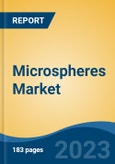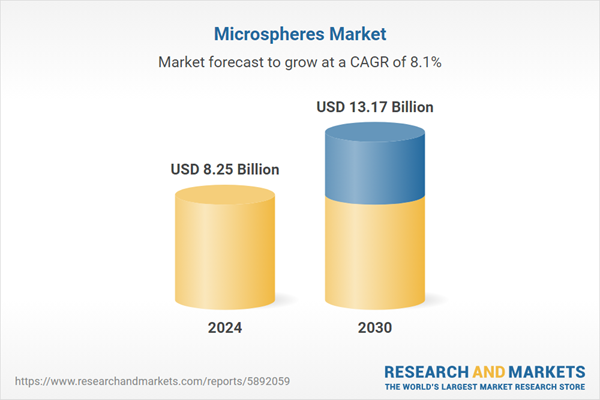Speak directly to the analyst to clarify any post sales queries you may have.
10% Free customizationThis report comes with 10% free customization, enabling you to add data that meets your specific business needs.
Industry leaders are leveraging microspheres to enhance product functionality and reduce overall material usage, particularly in high-performance composites, insulation systems, specialty coatings, and precision drug delivery platforms. The market is transitioning from commodity-based fillers to engineered, value-added microsphere solutions, tailored for sector-specific challenges. The microspheres market is set for long-term, demand-driven growth, with momentum fueled by aggressive R&D investment, cross-industry collaboration, and localized manufacturing strategies. Companies that focus on developing application-specific microsphere formulations and establishing scalable supply chains will be best positioned to capitalize on the expanding global footprint and evolving end-user requirements.
Key Market Drivers
Growing Demand of Microspheres in Pharmaceutical Applications
The growing demand for microspheres in pharmaceutical applications is playing a pivotal role in driving the expansion of the Global Microspheres Market, as the healthcare industry increasingly adopts advanced drug delivery systems and targeted therapeutic solutions. Microspheres offer a unique combination of controlled release, biocompatibility, and precision targeting, making them highly valuable across various pharmaceutical and biomedical applications. Microspheres are widely used as drug carriers in controlled and sustained release formulations.Their ability to encapsulate active pharmaceutical ingredients (APIs) and release them gradually at a specific site over a defined period significantly improves therapeutic efficacy and patient compliance. This technology is particularly critical in oncology, pain management, hormone therapy, and chronic disease treatments, where consistent dosing and reduced side effects are essential. Microspheres enable targeted drug delivery, allowing medications to be delivered directly to diseased tissues or organs while minimizing exposure to healthy cells. This targeted approach not only enhances treatment outcomes but also reduces systemic toxicity and side effects a critical consideration in cancer therapies and immunological treatments. As precision medicine gains traction globally, pharmaceutical companies are increasingly investing in microsphere-based delivery platforms.
Pharmaceutical-grade microspheres are used in injectable depots, implantable devices, and intra-tumoral therapies, where they serve as delivery agents for long-acting drugs. For instance, biodegradable polymer microspheres are employed to deliver drugs like leuprolide or risperidone over weeks or months with a single injection. This reduces dosing frequency and improves adherence, particularly in the treatment of psychiatric disorders and hormone-responsive cancers.
Microspheres are also gaining traction as contrast agents in diagnostic imaging, such as ultrasound and magnetic resonance imaging (MRI). Their uniform size and ability to be functionalized with targeting ligands make them ideal for visualizing specific biological markers or anatomical sites, enabling early disease detection and real-time monitoring of treatment response. This trend further broadens their scope within pharmaceutical and diagnostic applications.
Key Market Challenges
Material Selection and Customization
Microspheres are available in a wide range of materials, including glass, polymers, ceramics, metals, and composites. Each material possesses distinct characteristics that make it suitable for specific applications. For example, glass microspheres are known for their high strength and chemical resistance, while polymer microspheres offer flexibility and biocompatibility. The choice of material depends on various factors such as desired properties (density, thermal conductivity, electrical conductivity), compatibility with other materials, and manufacturing processes.When it comes to specific applications, microspheres often need to possess tailored properties. In the field of drug delivery systems, microspheres must provide controlled release, stability, and biocompatibility to ensure effective treatment. In electronics, microspheres may require high thermal conductivity or electrical insulation properties to enhance device performance. Achieving the desired properties requires careful material selection and customization.
Customizing microspheres to meet specific requirements can present challenges in the manufacturing process. The fabrication techniques used to produce microspheres play a crucial role in determining their physical and chemical properties. Different materials may require different manufacturing methods, such as emulsion polymerization, sol-gel synthesis, or spray drying. Each technique has its limitations and constraints, including particle size control, uniformity, scalability, and cost-effectiveness. Manufacturers must carefully consider these factors during the material selection process to ensure efficient customization.
Key Market Trends
Growing Demand of Green and Sustainable Microspheres
With mounting concerns about climate change, pollution, and resource depletion, industries are facing increasing pressure to adopt more sustainable practices. Microspheres, tiny particles widely used in various sectors such as automotive, construction, healthcare, and personal care, have emerged as a topic of interest for both manufacturers and consumers. The demand for eco-friendly alternatives to conventional microspheres is being driven by the shared desire to reduce environmental impacts throughout the entire product lifecycle.Conventional microspheres, typically made from non-biodegradable plastics or glass, can contribute to pollution and waste accumulation when not properly disposed of. In contrast, green and sustainable microspheres are designed to be biodegradable or made from eco-friendly materials. Biodegradable microspheres naturally break down over time, significantly reducing their impact on the environment. Eco-friendly materials for microspheres include natural polymers, recycled materials, or bio-based alternatives, all of which help minimize the use of non-renewable resources. The production of conventional microspheres often involves energy-intensive processes and the use of fossil-fuel-derived materials.
Key Market Players
- Bangs Laboratories Inc.
- 3M Company
- Chase Corporation
- Cospheric LLC
- Kureha Corporation
- Luminex Corporation (Diasorin Spa)
- Matsumoto Yushi-seiyaku Co. Ltd.
- Potters Industries LLC
- Siemens Healthineers AG
- Trelleborg AB
Report Scope:
In this report, the Global Microspheres Market has been segmented into the following categories, in addition to the industry trends which have also been detailed below:Microspheres Market, By Raw Material:
- Glass
- Polymer
- Ceramic
- Fly Ash
- Metallic
- Others
Microspheres Market, By Application:
- Automotive
- Aerospace
- Cosmetics
- Oil and Gas
- Paints and Coatings
- Others
Microspheres Market, By Region:
- North America
- United States
- Canada
- Mexico
- Europe
- France
- United Kingdom
- Italy
- Germany
- Spain
- Asia-Pacific
- China
- India
- Japan
- Australia
- South Korea
- South America
- Brazil
- Argentina
- Colombia
- Middle East & Africa
- South Africa
- Saudi Arabia
- UAE
Competitive Landscape
Company Profiles: Detailed analysis of the major companies present in the Global Microspheres Market.Available Customizations:
With the given market data, the publisher offers customizations according to a company's specific needs. The following customization options are available for the report.Company Information
- Detailed analysis and profiling of additional market players (up to five).
Table of Contents
Companies Mentioned
- Bangs Laboratories Inc.
- 3M Company
- Chase Corporation
- Cospheric LLC
- Kureha Corporation
- Luminex Corporation (Diasorin Spa)
- Matsumoto Yushi-seiyaku Co. Ltd.
- Potters Industries LLC
- Siemens Healthineers AG
- Trelleborg AB
Table Information
| Report Attribute | Details |
|---|---|
| No. of Pages | 180 |
| Published | August 2025 |
| Forecast Period | 2024 - 2030 |
| Estimated Market Value ( USD | $ 8.25 Billion |
| Forecasted Market Value ( USD | $ 13.17 Billion |
| Compound Annual Growth Rate | 8.1% |
| Regions Covered | Global |
| No. of Companies Mentioned | 10 |









